steering MAZDA MODEL CX-9 2011 (in English) User Guide
[x] Cancel search | Manufacturer: MAZDA, Model Year: 2011, Model line: MODEL CX-9, Model: MAZDA MODEL CX-9 2011Pages: 606, PDF Size: 13.55 MB
Page 151 of 606

Black plate (151,1)
NOTElDo not use glass cleaner or suspend objects
on or around the light sensor. Otherwise,
light sensor sensitivity will be affected and
may not operate normally.
Light sensor
Light sensor
lFor information regarding the 3 buttons
(
,,) on the auto-dimming
mirror, refer to HomeLink Wireless Control
System (page 5-76).
lThe auto-dimmer function is canceled when
the ignition is switched ON and the shift
lever/selector lever is in reverse (R).
Knowing Your Mazda
Steering Wheel and Mirrors
3-67
CX-9_8BH2-EA-10H_Edition3 Page151
Wednesday, March 23 2011 9:30 AM
Form No.8BH2-EA-10H
Page 157 of 606
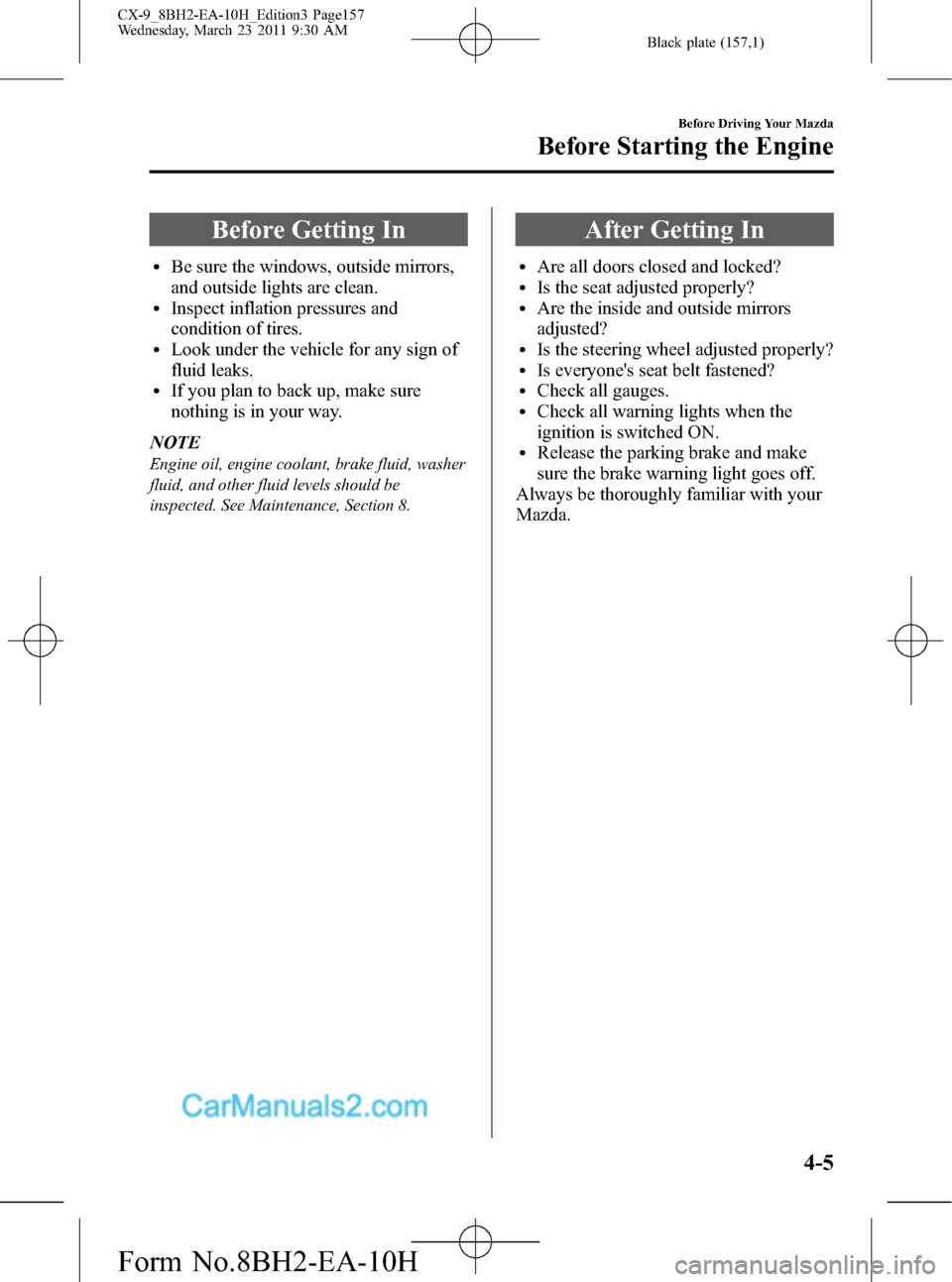
Black plate (157,1)
Before Getting In
lBe sure the windows, outside mirrors,
and outside lights are clean.
lInspect inflation pressures and
condition of tires.
lLook under the vehicle for any sign of
fluid leaks.
lIf you plan to back up, make sure
nothing is in your way.
NOTE
Engine oil, engine coolant, brake fluid, washer
fluid, and other fluid levels should be
inspected. See Maintenance, Section 8.
After Getting In
lAre all doors closed and locked?lIs the seat adjusted properly?lAre the inside and outside mirrors
adjusted?
lIs the steering wheel adjusted properly?lIs everyone's seat belt fastened?lCheck all gauges.lCheck all warning lights when the
ignition is switched ON.
lRelease the parking brake and make
sure the brake warning light goes off.
Always be thoroughly familiar with your
Mazda.
Before Driving Your Mazda
Before Starting the Engine
4-5
CX-9_8BH2-EA-10H_Edition3 Page157
Wednesday, March 23 2011 9:30 AM
Form No.8BH2-EA-10H
Page 158 of 606
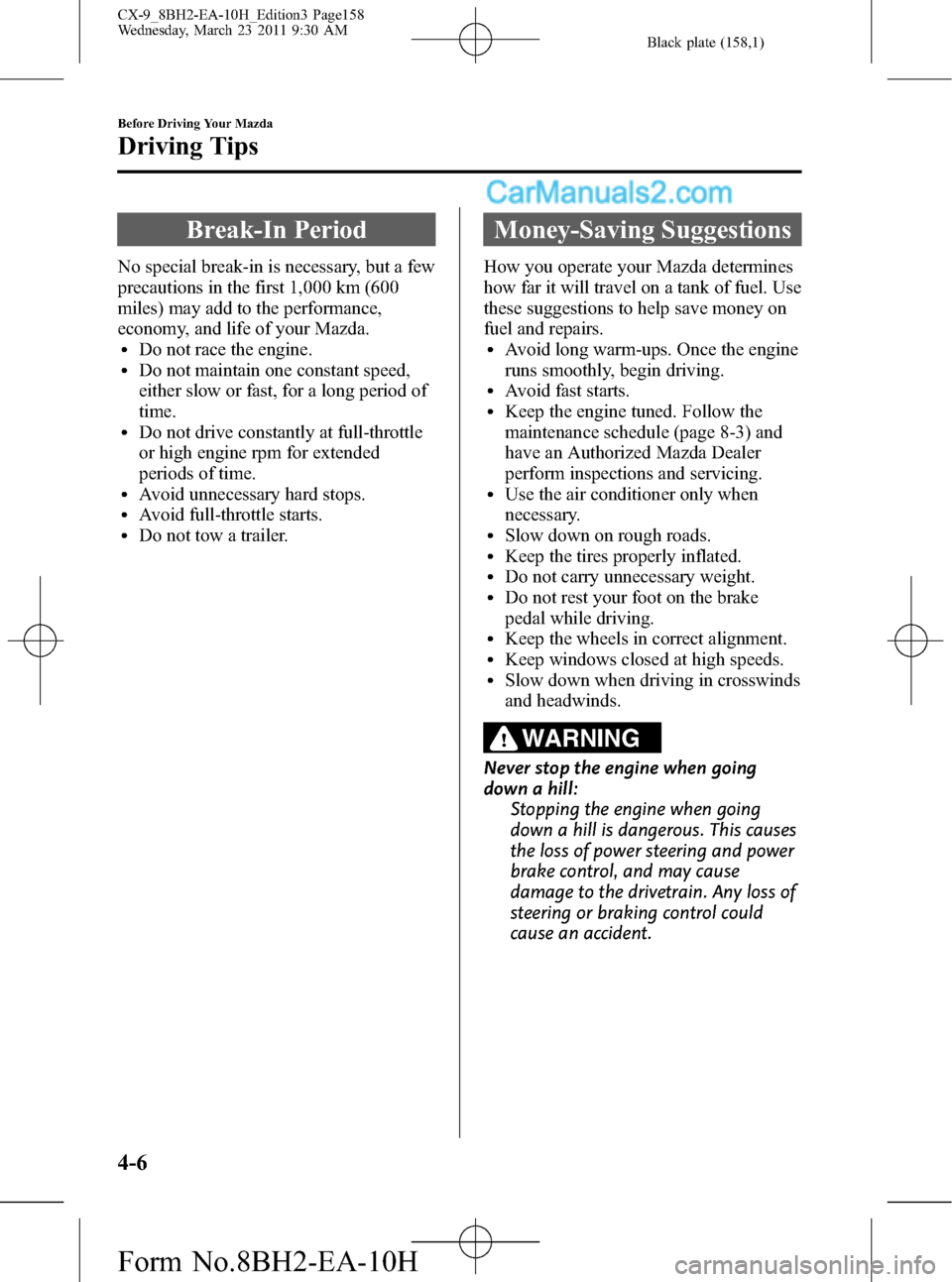
Black plate (158,1)
Break-In Period
No special break-in is necessary, but a few
precautions in the first 1,000 km (600
miles) may add to the performance,
economy, and life of your Mazda.
lDo not race the engine.lDo not maintain one constant speed,
either slow or fast, for a long period of
time.
lDo not drive constantly at full-throttle
or high engine rpm for extended
periods of time.
lAvoid unnecessary hard stops.lAvoid full-throttle starts.lDo not tow a trailer.
Money-Saving Suggestions
How you operate your Mazda determines
how far it will travel on a tank of fuel. Use
these suggestions to help save money on
fuel and repairs.
lAvoid long warm-ups. Once the engine
runs smoothly, begin driving.
lAvoid fast starts.lKeep the engine tuned. Follow the
maintenance schedule (page 8-3) and
have an Authorized Mazda Dealer
perform inspections and servicing.
lUse the air conditioner only when
necessary.
lSlow down on rough roads.lKeep the tires properly inflated.lDo not carry unnecessary weight.lDo not rest your foot on the brake
pedal while driving.
lKeep the wheels in correct alignment.lKeep windows closed at high speeds.lSlow down when driving in crosswinds
and headwinds.
WARNING
Never stop the engine when going
down a hill:
Stopping the engine when going
down a hill is dangerous. This causes
the loss of power steering and power
brake control, and may cause
damage to the drivetrain. Any loss of
steering or braking control could
cause an accident.
4-6
Before Driving Your Mazda
Driving Tips
CX-9_8BH2-EA-10H_Edition3 Page158
Wednesday, March 23 2011 9:30 AM
Form No.8BH2-EA-10H
Page 160 of 606
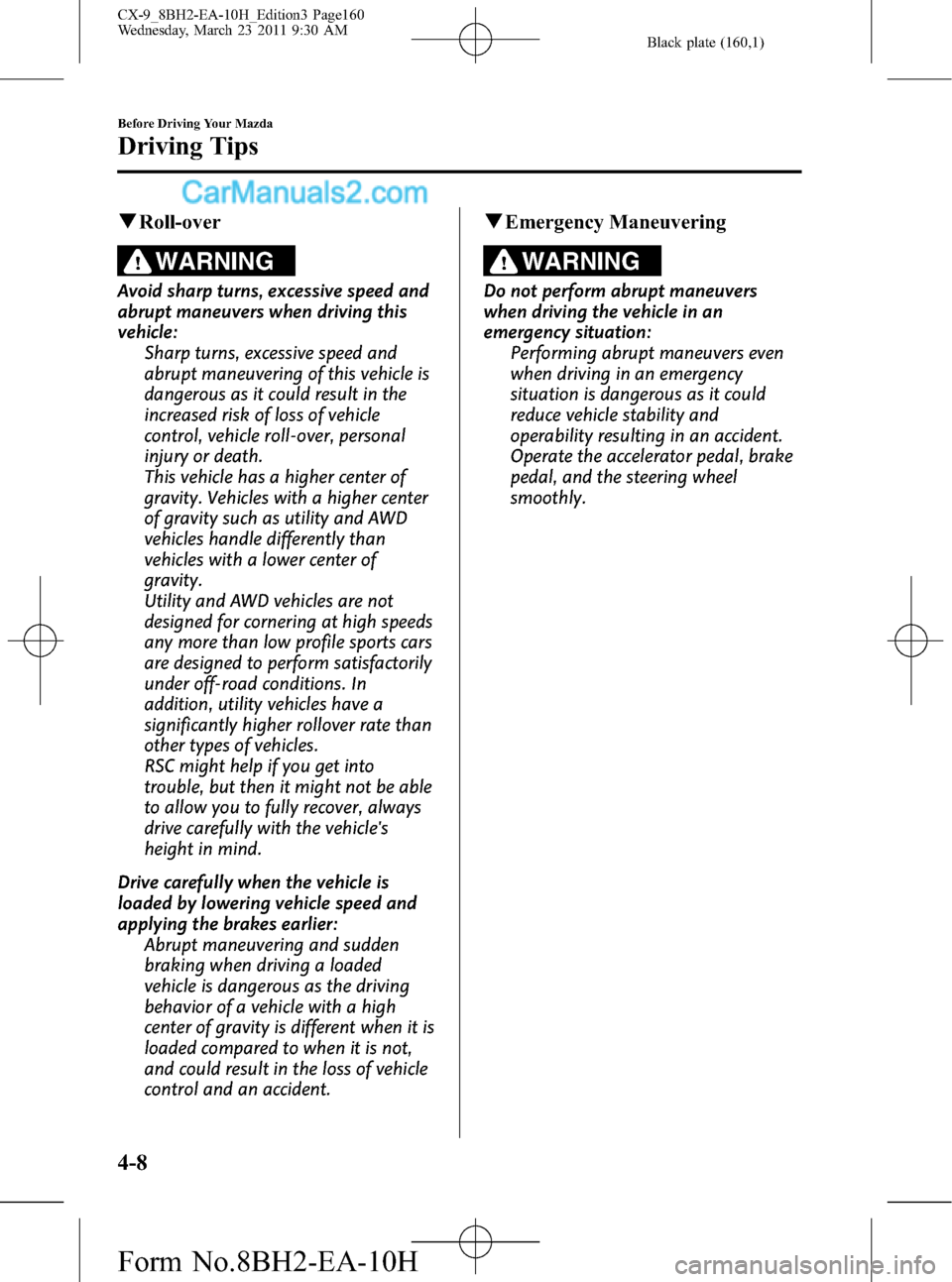
Black plate (160,1)
qRoll-over
WARNING
Avoid sharp turns, excessive speed and
abrupt maneuvers when driving this
vehicle:
Sharp turns, excessive speed and
abrupt maneuvering of this vehicle is
dangerous as it could result in the
increased risk of loss of vehicle
control, vehicle roll-over, personal
injury or death.
This vehicle has a higher center of
gravity. Vehicles with a higher center
of gravity such as utility and AWD
vehicles handle differently than
vehicles with a lower center of
gravity.
Utility and AWD vehicles are not
designed for cornering at high speeds
any more than low profile sports cars
are designed to perform satisfactorily
under off-road conditions. In
addition, utility vehicles have a
significantly higher rollover rate than
other types of vehicles.
RSC might help if you get into
trouble, but then it might not be able
to allow you to fully recover, always
drive carefully with the vehicle's
height in mind.
Drive carefully when the vehicle is
loaded by lowering vehicle speed and
applying the brakes earlier:
Abrupt maneuvering and sudden
braking when driving a loaded
vehicle is dangerous as the driving
behavior of a vehicle with a high
center of gravity is different when it is
loaded compared to when it is not,
and could result in the loss of vehicle
control and an accident.
qEmergency Maneuvering
WARNING
Do not perform abrupt maneuvers
when driving the vehicle in an
emergency situation:
Performing abrupt maneuvers even
when driving in an emergency
situation is dangerous as it could
reduce vehicle stability and
operability resulting in an accident.
Operate the accelerator pedal, brake
pedal, and the steering wheel
smoothly.
4-8
Before Driving Your Mazda
Driving Tips
CX-9_8BH2-EA-10H_Edition3 Page160
Wednesday, March 23 2011 9:30 AM
Form No.8BH2-EA-10H
Page 171 of 606
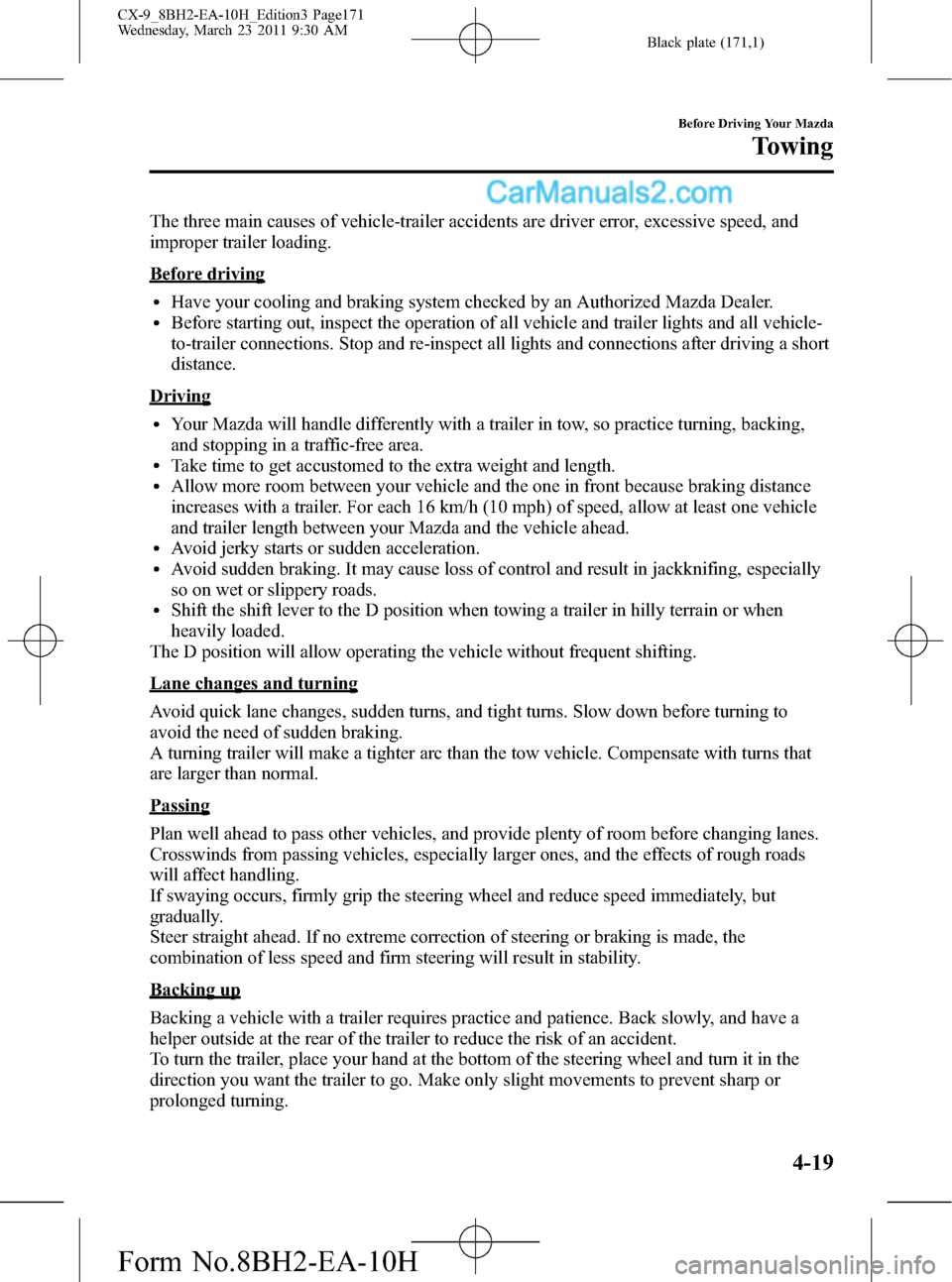
Black plate (171,1)
The three main causes of vehicle-trailer accidents are driver error, excessive speed, and
improper trailer loading.
Before driving
lHave your cooling and braking system checked by an Authorized Mazda Dealer.lBefore starting out, inspect the operation of all vehicle and trailer lights and all vehicle-
to-trailer connections. Stop and re-inspect all lights and connections after driving a short
distance.
Driving
lYour Mazda will handle differently with a trailer in tow, so practice turning, backing,
and stopping in a traffic-free area.
lTake time to get accustomed to the extra weight and length.lAllow more room between your vehicle and the one in front because braking distance
increases with a trailer. For each 16 km/h (10 mph) of speed, allow at least one vehicle
and trailer length between your Mazda and the vehicle ahead.
lAvoid jerky starts or sudden acceleration.lAvoid sudden braking. It may cause loss of control and result in jackknifing, especially
so on wet or slippery roads.
lShift the shift lever to the D position when towing a trailer in hilly terrain or when
heavily loaded.
The D position will allow operating the vehicle without frequent shifting.
Lane changes and turning
Avoid quick lane changes, sudden turns, and tight turns. Slow down before turning to
avoid the need of sudden braking.
A turning trailer will make a tighter arc than the tow vehicle. Compensate with turns that
are larger than normal.
Passing
Plan well ahead to pass other vehicles, and provide plenty of room before changing lanes.
Crosswinds from passing vehicles, especially larger ones, and the effects of rough roads
will affect handling.
If swaying occurs, firmly grip the steering wheel and reduce speed immediately, but
gradually.
Steer straight ahead. If no extreme correction of steering or braking is made, the
combination of less speed and firm steering will result in stability.
Backing up
Backing a vehicle with a trailer requires practice and patience. Back slowly, and have a
helper outside at the rear of the trailer to reduce the risk of an accident.
To turn the trailer, place your hand at the bottom of the steering wheel and turn it in the
direction you want the trailer to go. Make only slight movements to prevent sharp or
prolonged turning.
Before Driving Your Mazda
Towing
4-19
CX-9_8BH2-EA-10H_Edition3 Page171
Wednesday, March 23 2011 9:30 AM
Form No.8BH2-EA-10H
Page 172 of 606
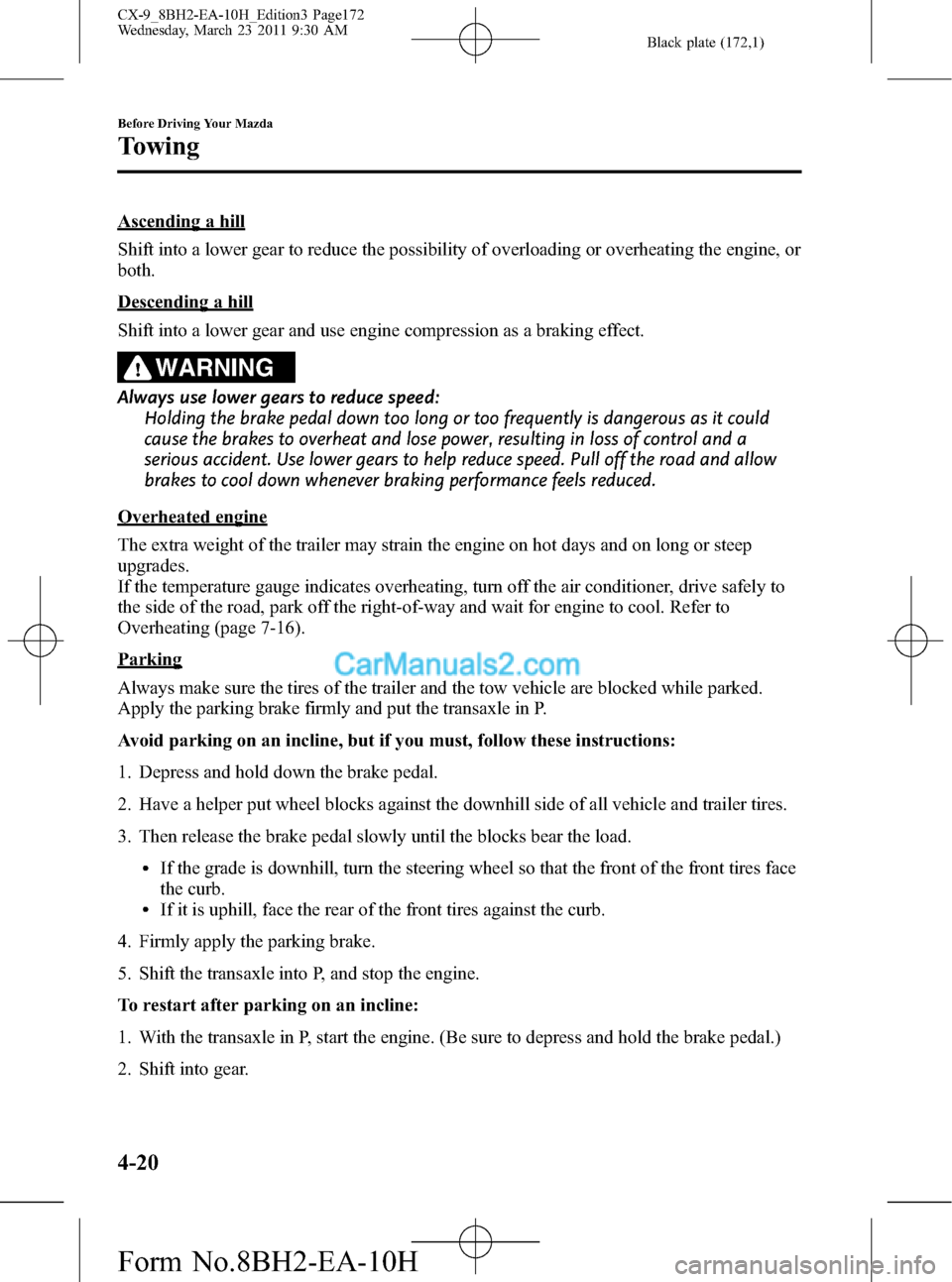
Black plate (172,1)
Ascending a hill
Shift into a lower gear to reduce the possibility of overloading or overheating the engine, or
both.
Descending a hill
Shift into a lower gear and use engine compression as a braking effect.
WARNING
Always use lower gears to reduce speed:
Holding the brake pedal down too long or too frequently is dangerous as it could
cause the brakes to overheat and lose power, resulting in loss of control and a
serious accident. Use lower gears to help reduce speed. Pull off the road and allow
brakes to cool down whenever braking performance feels reduced.
Overheated engine
The extra weight of the trailer may strain the engine on hot days and on long or steep
upgrades.
If the temperature gauge indicates overheating, turn off the air conditioner, drive safely to
the side of the road, park off the right-of-way and wait for engine to cool. Refer to
Overheating (page 7-16).
Parking
Always make sure the tires of the trailer and the tow vehicle are blocked while parked.
Apply the parking brake firmly and put the transaxle in P.
Avoid parking on an incline, but if you must, follow these instructions:
1. Depress and hold down the brake pedal.
2. Have a helper put wheel blocks against the downhill side of all vehicle and trailer tires.
3. Then release the brake pedal slowly until the blocks bear the load.
lIf the grade is downhill, turn the steering wheel so that the front of the front tires face
the curb.
lIf it is uphill, face the rear of the front tires against the curb.
4. Firmly apply the parking brake.
5. Shift the transaxle into P, and stop the engine.
To restart after parking on an incline:
1. With the transaxle in P, start the engine. (Be sure to depress and hold the brake pedal.)
2. Shift into gear.
4-20
Before Driving Your Mazda
Towing
CX-9_8BH2-EA-10H_Edition3 Page172
Wednesday, March 23 2011 9:30 AM
Form No.8BH2-EA-10H
Page 175 of 606
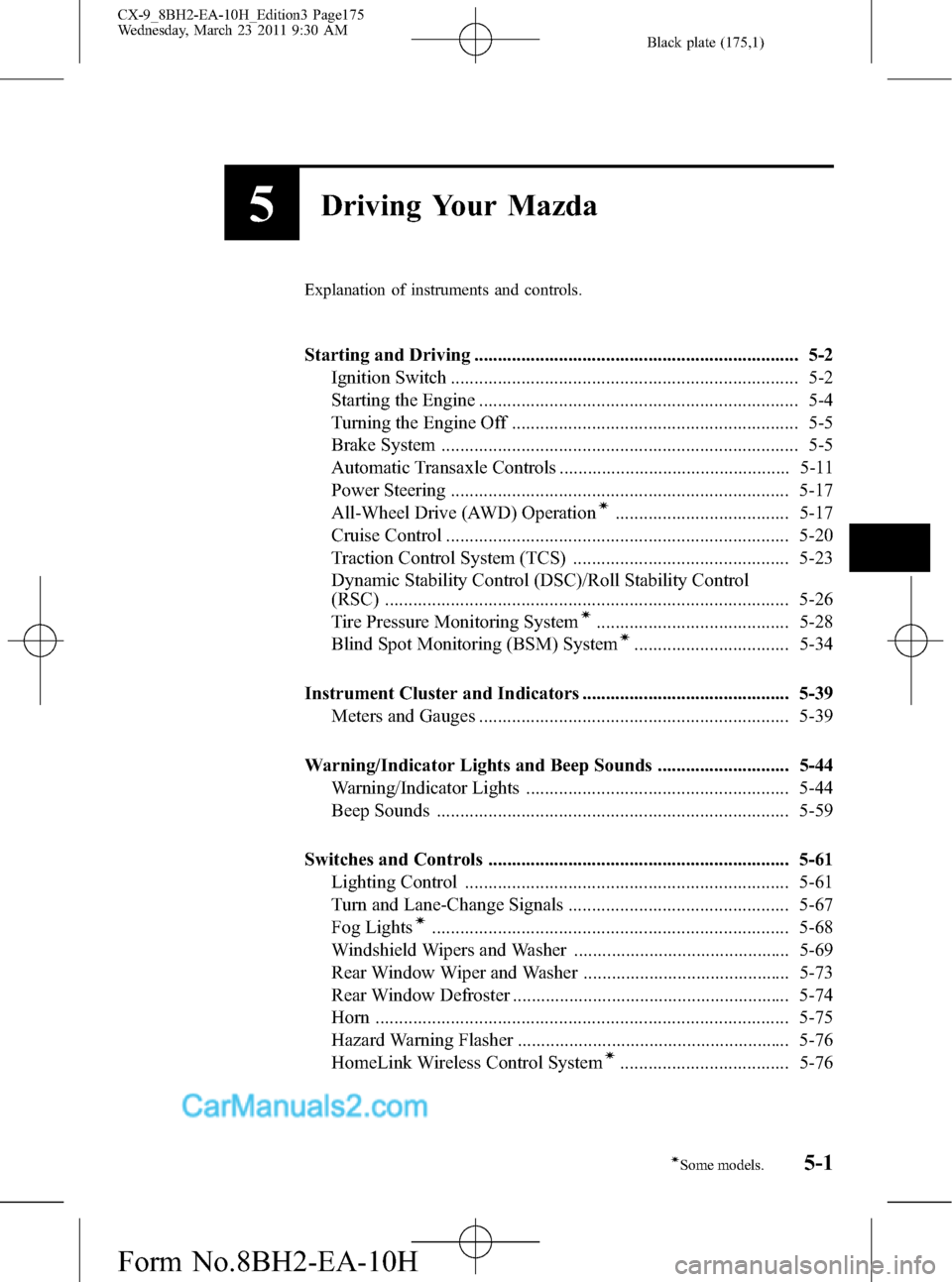
Black plate (175,1)
5Driving Your Mazda
Explanation of instruments and controls.
Starting and Driving ..................................................................... 5-2
Ignition Switch .......................................................................... 5-2
Starting the Engine .................................................................... 5-4
Turning the Engine Off ............................................................. 5-5
Brake System ............................................................................ 5-5
Automatic Transaxle Controls ................................................. 5-11
Power Steering ........................................................................ 5-17
All-Wheel Drive (AWD) Operation
í..................................... 5-17
Cruise Control ......................................................................... 5-20
Traction Control System (TCS) .............................................. 5-23
Dynamic Stability Control (DSC)/Roll Stability Control
(RSC) ...................................................................................... 5-26
Tire Pressure Monitoring System
í......................................... 5-28
Blind Spot Monitoring (BSM) Systemí................................. 5-34
Instrument Cluster and Indicators ............................................ 5-39
Meters and Gauges .................................................................. 5-39
Warning/Indicator Lights and Beep Sounds ............................ 5-44
Warning/Indicator Lights ........................................................ 5-44
Beep Sounds ........................................................................... 5-59
Switches and Controls ................................................................ 5-61
Lighting Control ..................................................................... 5-61
Turn and Lane-Change Signals ............................................... 5-67
Fog Lights
í............................................................................ 5-68
Windshield Wipers and Washer .............................................. 5-69
Rear Window Wiper and Washer ............................................ 5-73
Rear Window Defroster ........................................................... 5-74
Horn ........................................................................................ 5-75
Hazard Warning Flasher .......................................................... 5-76
HomeLink Wireless Control System
í.................................... 5-76
5-1íSome models.
CX-9_8BH2-EA-10H_Edition3 Page175
Wednesday, March 23 2011 9:30 AM
Form No.8BH2-EA-10H
Page 177 of 606

Black plate (177,1)
WARNING
Remove the key only when the vehicle
is parked (with steering lock
mechanism):
Removing the key from the ignition
switch while the vehicle is moving is
dangerous. Removing the key allows
the steering wheel to lock. You will
lose steering control and a serious
accident could occur. (For vehicles
equipped with the advanced key, the
steering wheel locks when the starter
knob is turned to the OFF/LOCK
position.)
Before leaving the driver's seat, always
switch the ignition to OFF/LOCK, set the
parking brake and make sure the shift
lever is in P:
It is important to switch the ignition
to OFF/LOCK even if you are not
removing the key from the ignition or
leaving the vehicle. Leaving the key
in other positions will disable some of
the vehicle security systems and run
the battery down.
Leaving the driver's seat without
switching the ignition to OFF/LOCK,
setting the parking brake and
shifting the shift lever to P is
dangerous. Unexpected vehicle
movement could occur. This could
cause an accident.
NOTE
If turning the key is difficult, jiggle the steering
wheel from side to side.
Leaving the key or start knob in any position
but the OFF/LOCK position also disables
some of the security features and may run the
battery down.
ACC (Accessory)
In this position, some electrical
accessories will operate.
ON
This is the normal running position after
the engine is started. Some indicator
lights/warning lights should be inspected
before the engine is started (page 5-44).
NOTE
When the ignition is switched ON, the sound of
the fuel pump motor operating near the fuel
tank can be heard. This does not indicate an
abnormality.
NOTE
Vibration of the brake pedal may be felt when
the ignition is switched ON, however, this is a
normal operation of the DSC/RSC and does
not indicate an abnormality.
START
The engine is started in this position. It
will crank until you release the key. It
then returns to the ON position.
qIgnition Key Reminder
If the ignition is switched off or the
ignition is switched to ACC with the key
inserted, a continuous beep sound will be
heard when the driver's door is opened.
Driving Your Mazda
Starting and Driving
5-3
CX-9_8BH2-EA-10H_Edition3 Page177
Wednesday, March 23 2011 9:30 AM
Form No.8BH2-EA-10H
Page 179 of 606

Black plate (179,1)
Turning the Engine Off
1. Stop the vehicle completely.
2. Shift the shift lever to the P position.
3. Switch the ignition from ON to OFF/
LOCK.
WARNING
Do not stop the engine while the
vehicle is moving:
Stopping the engine while the vehicle
is moving for any reason other than
in an emergency is dangerous.
Stopping the engine while the vehicle
is moving will result in reduced
maneuverability and braking ability
due to the loss of power steering and
power braking, which could cause an
accident and serious injury.
CAUTION
When leaving the vehicle, make sure
the ignition is switched off.
Brake System
qFoot Brake
Your Mazda has power-assisted brakes
that adjust automatically through normal
use.
Should power-assist fail, you can stop by
applying greater force than normal to the
brake pedal. But the distance required to
stop will be greater than usual.
Driving Your Mazda
Starting and Driving
5-5
CX-9_8BH2-EA-10H_Edition3 Page179
Wednesday, March 23 2011 9:30 AM
Form No.8BH2-EA-10H
Page 190 of 606

Black plate (190,1)
During deceleration, the gears shift down
automatically when speed is reduced to
the following:
Gear Vehicle speed
M6→M5 47 km/h (29 mph)
M5→M4 37 km/h (22 mph)
M4→M3 26 km/h (16 mph)
M3 or M2→M1 7 km/h (4 mph)
NOTE
The gear does not shift down to M1
automatically while in the second gear fixed
mode.
If the vehicle is kicked down at the
following speeds or lower, the gears shift
down automatically:
Gear Vehicle speed
M6→M5 230 km/h (142 mph)
M5→M4 90 km/h (55 mph)
M4→M3 65 km/h (40 mph)
M3→M2 40 km/h (24 mph)
Recommendations for shifting
Upshifting
For normal acceleration and cruising, we
recommend these shift points.
Gear Vehicle speed
M1 to M2 24 km/h (15 mph)
M2 to M3 40 km/h (25 mph)
M3 to M4 65 km/h (40 mph)
M4 to M5 73 km/h (45 mph)
M5 to M6 80 km/h (50 mph)
Downshifting
When you must slow down in heavy
traffic or on a steepupgrade, downshift
before the engine starts to overwork. This
gives better acceleration when you need
more speed.On a steepdowngrade, downshifting
helps maintain safe speed and prolongs
brake life.
qDriving Tips
WARNING
Do not allow the vehicle to move in
reverse on an up-slope while the
selector lever is in a forward gear
position, or move forward on a down-
slope while the selector lever is in the
reverse position.
Otherwise, the engine will stop,
causing the loss of the power brake
and power steering functions, and
make it difficult to control the vehicle
which could result in an accident.
Passing
For extra power when passing another
vehicle or climbing steep grades, depress
the accelerator fully. The transaxle will
shift to a lower gear, depending on vehicle
speed.
Climbing steep grades from a stop
To climb a steep grade from a stopped
position:
1. Depress the brake pedal.
2. Shift to D or M1, depending on the
load weight and grade steepness.
3. Release the brake pedal while
gradually accelerating.
Descending steep grades
When descending a steep grade, shift to
lower gears, depending on load weight
and grade steepness. Descend slowly,
using the brakes only occasionally to
prevent them from overheating.
5-16
Driving Your Mazda
Starting and Driving
CX-9_8BH2-EA-10H_Edition3 Page190
Wednesday, March 23 2011 9:30 AM
Form No.8BH2-EA-10H